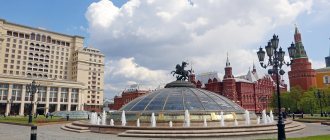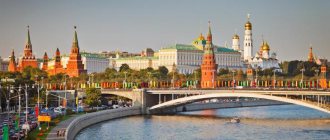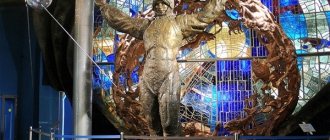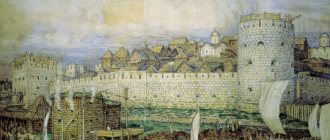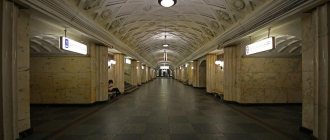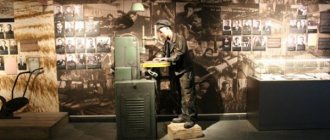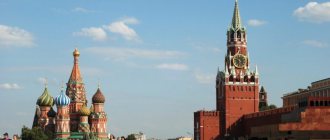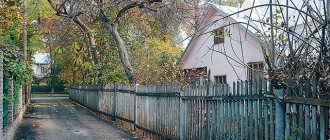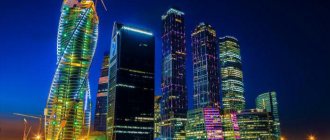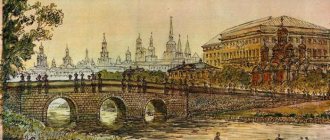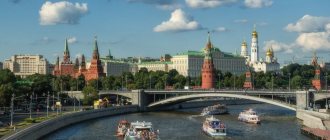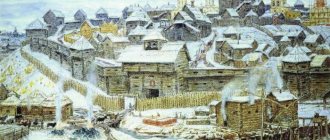Walking around Moscow, as a special form of leisure, is equally interesting for tourists from different countries, for guests of the capital from other Russian cities, and for the city residents themselves . It is physically impossible to see all the interesting places at once, but planning a cultural program for a week is quite possible. “My Home Moscow” offers seven options for walking tours to the most interesting places in the capital. With our simple navigator, exciting leisure time for a whole week is guaranteed.
Pedestrian areas and streets
If at the beginning of the 2000s the capital was a city for motorists, then in the last few years new pedestrian zones of Moscow , free from transport, have appeared in the center. This allows you to relax comfortably in peace and quiet, and easily reach the metro and remote residential areas of the metropolis on foot.
The capital's recently appeared pedestrian promenade points have a unique ancient architecture, there are cafes and restaurants, and there is all the necessary infrastructure for a comfortable stay. Such streets are very popular among tourists, who can simultaneously explore all the beauties and main attractions of the capital. List of main Moscow pedestrian zones:
- Red Square area.
- Bolshaya Dmitrovka.
- Lavrushinsky lane.
- Kamergersky Lane.
- Crimean Bridge.
- Embankment of the Moscow River.
- Old Arbat.
- Boulevard Ring.
Most of the capital's iconic places are located here. Sightseeing tours and guides to pedestrian streets and zones are popular among tourists, allowing them to get closer to the history and modern life of the Russian capital.
What will be improved
- Kievsky station area
- Khrustalny Lane
- Dmitrovsky Lane
- Leninsky Prospekt
- Krasnaya Presnya Street
- Zvenigorodskoye Highway (from Barrikadnaya metro station to the Third Transport Ring)
- Andropov Avenue (from Kolomenskaya metro station to Lipetskaya street)
20 kilometers for recreation. Moscow and the Moscow region will be connected by the Yauza superpark More details
Varvarka and Zaryadye
The Zaryadye district changed beyond recognition in 2016-2017, when a park area was created on the site of the demolished Rossiya Hotel. Varvarka Street is one of the oldest in the capital; it connects the established Zaryadye Garden Park with city attractions. In ancient times, it was in this area that the history of Moscow, and subsequently the entire Russian Empire, began.
Pedestrian Varvarka is a real pearl of Kitay-Gorod. There are a large number of attractions within walking distance, including the Old Tsar's Court, the Temple of St. Gregory the Victorious, the white-stone Romanov estate and the Old English Court. Walking along Varvarka and Zaryadye will appeal to those who like a quiet, unhurried holiday. There are also thematic excursions dedicated to the history of Moscow.
Walking through the center of the capital
Walking through the center of Moscow
A wonderful 5-kilometer route passes through many of Moscow's sights. During your walk you can stop by for some shopping. The starting point of this little journey through the center of the capital will be Theater Square. From here the road will go towards Kitai-Gorod and Lubyanka. From here we turn into the old Moscow lanes and move towards GUM for shopping. After walking around the boutiques to your heart’s content, you can take a couple of memorable photos against the backdrop of the Kremlin for Instagram, while simultaneously looking at the historical part of the city and admiring the beauty of the spacious center of Moscow. The end of the walk will be the Ploshchad Revolutsii metro station.
Chernigovsky and Klimentovsky lanes
Not far from the Novokuznetskaya metro station is Chernigovsky Lane, which is one of the few streets in Moscow practically untouched by time. The lane got its name from the tavern that was located here in the 18th century. It is located at the intersection with Pyatnitskaya not far from the ancient white stone high bell tower built in 1781. Here you will also find the beautiful Temple of the Truncation of John the Baptist, the ancient patriarchal courtyard and the Church of the Chernigov Wonderworkers of Boyar Fyodor and Prince Mikhail.
The highlights of this pedestrian lane include four red brick mansions dating back to the 18th century. Currently, these historical buildings house the Foundation of Slavic Literature and the Igor Talkov Museum. This is a quiet, calm pedestrian street, where there are also open summer cafes and restaurants where you can have a hearty and inexpensive lunch or dinner.
A hundred meters from Chernigovskaya Street is Klimentovsky Lane. This is a quiet pedestrian street lined with small restaurants and coffee shops with a pleasant relaxing atmosphere. Among the attractions is the Clement Church , built at the end of the 18th century. This is a real Zamoskvoretsk miracle, which has been preserved in its original original form. Today, the Church of St. Clement is called one of the five best churches in the capital, including in many sightseeing tours of Moscow.
Klementovsky Lane will take you back several centuries. Here you can sit in the shade of small trees, examine the architecture, and visit restaurants serving Russian and Georgian cuisine.
Trading Pyatnitskaya
Behind the Moscow River in the very center of the city is the pedestrian street Pyatnitskaya. In the 19th century, the road from the capital to Tula and Ryazan passed here, shopping arcades were built here, and today, after a large-scale reconstruction, a comfortable and cozy pedestrian zone has been created. This place is popular among residents of the capital; ancient buildings are adjacent to green areas, cafes and restaurants, where you can have a great rest with the whole family.
One of the main attractions of Pyatnitskaya is the Church of the Life-Giving Trinity. The church was built at the beginning of the 16th century and has reached our times almost in its original form. There are estates and merchant mansions dating back to the 18th and 19th centuries. Many people know the House of Lions, which in the past belonged to the banker Jacob Rekka. Here is the Tolstoy Cultural Center, a tour of the exhibitions of which will allow you to get acquainted with the work of the great Russian writer.
Shkolnaya (formerly Telezhnaya)
In the center of the capital there is Shkolnaya Street (formerly Telezhnaya Street). In this area, time seemed to stop a couple of centuries ago. The buildings of the 19th century have been preserved here in their original form, and the quarter itself is a capital open-air museum of architecture. It is known that Telezhnaya began to be called Shkolnaya only in the last century, when several large lyceums were built on it.
In the 16th-18th centuries, Old Believers lived on Telezhnaya Street. The strict demands of the community on daily life left their mark on the surrounding area. The architecture of the buildings is neat, without frills, but memorable and unusual. Shkolnaya Street itself is wide, surrounded by greenery, which is uncharacteristic of modern Moscow.
At the beginning of Shkolnaya Street, not far from its intersection with Bolshaya Andronyevskaya, there is the historical ensemble of Yamskaya Rogozhskaya Sloboda of the 18th-19th centuries. The merchant atmosphere of Moscow has been preserved here, which makes such walks interesting for citizens and tourists. After the reconstruction, the pedestrian zone was expanded, bicycle paths and routes for hydro scooters were laid.
Along the monumental houses to the Novodevichy Convent
Along monumental houses
The walking route along monumental houses from the heyday of Soviet architecture runs from the Frunzenskaya metro station through a small park at the Trubetskoy estate towards the Novodevichy Convent. Wealthy Muscovites settled in this prestigious area, and houses for them were built, as they say, to last. After visiting the monastery, you can go for a walk along Frunzenskaya Embankment.
Spiridonovka and Krutitskaya
Not far from Shkolnaya there is Krutitskaya Street, on which the Krutitsky Compound complex is located. At the beginning of the 2000s, a complete reconstruction was carried out in this area, which allowed the buildings and structures to return to their original appearance. It is known that the courtyard was founded in the 13th century, and its main object is the Church of Peter and Paul. In the past, it was from here that Russian princes went to the marching border and the horde, asking for God’s blessing for a safe return back.
After reconstruction, the ancient Assumption Cathedral was completely restored, and the stone pavement, which dates back to the 19th century, was restored. Today there is a pedestrian zone here, which is popular among tourists and Moscow residents. Here you can wander through the quiet streets and examine the buildings, some of which are 600-700 years old. Today, Krutitskaya Street is included in most sightseeing walking tours of the capital, allowing you to get acquainted with the early history of the city . The main listed attractions of this quarter are:
- Temple of the Apostles Peter and Paul;
- Merchants' farmsteads;
- Chamber of the Faceted Court.
In the Central District, at the intersection of Granatny Lane and Malaya Nikitskaya, there is Spiridonov Street, which many call one of the most beautiful in Moscow. On a small area there are three unique historical architectural buildings - the Ryabushinsky mansion, the building of the Chamber of the Faceted Court and the majestic ancient Temple of the Great Ascension. There is a walking tourist tram route, the detailed route of which can be found at the information desks.
It is a known fact that the great Russian poet Alexander Pushkin got married in a small church on Spiridonovka. On the nearest corner, not far from Nikitskaya Street, there is an old house in which Alexei Tolstoy previously lived. Today this area is considered perhaps the best for leisurely walking walks in Moscow. Spiridonovka Street is surrounded by greenery, there are many small restaurants and cafes, and you can also just sit on benches in the shade of huge trees.
Museum park near the Polytechnic Museum
Photo: Anton Belitsky
Photo: Anton Belitsky
Photo: Anton Belitsky
Photo: Mobile reporter (AGN “Moscow”)
Photo: Mobile reporter (AGN “Moscow”)
For several years, the building of the Polytechnic Museum and the square near it were hidden by fences, advertising banners and scaffolding, and finally, between Novaya Square and Lubyansky Proezd, a modern urban space, designed in the best traditions of modern times, opened. Its main feature is its multi-level nature. In the new version of the layout, it will be possible to enter the Polytech from the ground floor - on the same lower level, the authors of the project laid out a large area and pedestrian paths, which are decorated with figured benches and flower beds. Naturally, the space was generously landscaped - 62 trees and 1,105 shrubs were planted.
The most striking element of the multi-level design is, of course, the amphitheater, which, by the way, has already been dubbed the second “Pit” - by analogy with Khokhlovskaya Square, where an archaeological park was built around a fragment of the wall of the old White City. The second “floor” of the park has also turned into a convenient walking area, from which bridges “branch” leading to other entrances to the building.
However, the “Museum Park” is not just a landscaped area around the Polytechnic University (the museum itself, by the way, will not open until next year). The space also plays a much more important role: it unites the existing pedestrian routes of the center into a single public space - from Lubyanka to Zaryadye Park (read also: “Zaryadye Park: about Russia with love”). Thus, Yama-2 has become another link in creating a continuous urban environment that is friendly to pedestrians.
Museum Park, Moscow
View on map
Nikolskaya and Bolshaya Dmitrovka
Nikolskaya and Bolshaya Dmitrovka streets are probably one of the most famous and popular pedestrian areas among tourists in the capital. They are located in the very center of Moscow, close to each other, which allows you to take fascinating walks and get acquainted with the ancient history of the city. In tourist brochures you can read what Bolshaya Dmitrovka was like in the past, find out whether Nikolskaya Street is pedestrian or not, and also get acquainted with the ancient architecture of this area. Tourists while visiting Nikolskaya can:
- explore ancient architecture;
- sit in a cafe;
- see exhibitions telling about the history of Moscow.
The architectural appearance of Bolshaya Dmitrovka was formed in the 18th-19th centuries. After reconstruction, all buildings were restored to their original form and included in the list of historical buildings of the capital. There are also cafes and restaurants for every taste and budget, where you can have a great rest and eat delicious food. On Dmitrovka and Nikolskaya, magnificent evening lighting is organized and lanterns are installed, which allows you to admire the architecture of these streets.
After a large-scale reconstruction, Nikolskaya Street, which stretches from Red Square to Lubyanka, became pedestrian. This is the historical center of Moscow, with buildings dating back to the 17th and 18th centuries . Some may find Nikolskaya too noisy and fussy, but this is where you can immerse yourself in the bustling atmosphere of the metropolis.
Travel from Tsvetnoy Boulevard to Kitay-Gorod
Traveling from Tsvetnoy Boulevard to Kitay-gorod
Another fascinating walk can be taken along Tsvetnoy Boulevard with its main attractions - the monument to Yuri Nikulin, the Old Moscow Circus on Tsvetnoy Boulevard and the fountain with clowns across the road. Moving towards Trubnaya Square you can see the largest felt boots in the world, as well as a stele crowned with the figure of St. George the Victorious.
Next, we head towards Rozhdestvenka Street and go towards Kuznetsky Most. There we look at the observation deck of the Central Children's World. We return to Rozhdestvensky Boulevard again, and from there we go to Chistye Prudy, once sung in the lyrical ballad of David Tukhmanov and Leonid Fadeev performed by Igor Talkov. From there we go to Pokrovka. The route ends with the already familiar China Town.
Old Arbat
Old Arbat is one of the most famous and popular pedestrian areas in the city. The street is part of the cultural life of Moscow. The length of Old Arbat today exceeds one kilometer, so there is somewhere to walk here at any time of the day or night. Dancers and street musicians constantly perform here, and artists can paint a portrait in any style. Most of the buildings and structures on Arbat have been preserved in their original form; there are also open-air cafes where it is so pleasant to spend an evening, resting your soul and body.
Nearby is New Arbat, which in recent years has also become one of the city's attractions. There are iconic places and objects of interest to tourists. In booklets and guidebooks you can read about whether New Arbat is pedestrian or not, and also learn the history of this street.
